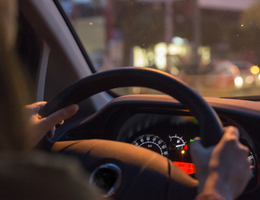
Nov. 2, 2023—Shorter winter days mean you’re more likely to find yourself driving after dark. Whether you’re headed home from work, going out for the evening or taking a trip, be extra careful driving when the sun is down.
Here’s why:
- Your visibility at night is only about 250 feet with your headlights on—about 500 feet with the high beams.
- Your peripheral vision and depth perception aren’t as good.
- You can be momentarily blinded by another driver’s bright headlights.
- You’re more likely to be fatigued. Drowsy driving is a major risk factor for accidents, the Centers for Disease Control and Prevention says.
- During evening rush hour, drivers may be more impatient—which may lead to mistakes or aggressive driving.
- Drivers who are impaired by alcohol are more likely to be on the road at night.
From dusk till dawn
Safe habits—and the right equipment—can help you stay safe if you’re on the road after sunset. These tips from the American Optometric Association can help steer you right.
Maintain a clean machine. Keep the windshield and rear window clear of dirt and smudges. Replace your wipers if they are leaving streaks. And don’t forget to clean the headlight coverings.
Optimize lighting. High beams can double your visibility, giving you more time to react to hazards on the road ahead. Use them anytime you’re alone on the road. But take care to switch back to your regular headlights when a car is approaching or when you’re behind another car. And remember, high beams won’t help on foggy nights—they can make visibility worse.
Protect your vision. Dim your dashboard lights to reduce glare, and use the nighttime setting on your rearview mirror to dim headlight glare from behind you. Blink often to keep your eyes from becoming too dry. If you wear glasses, keep them clean and make sure your prescription is current. If you’re having trouble seeing at night, let your eye doctor know.
Slow down. Reducing your speed allows you more time to react to something in the road. If roads aren’t well-lighted, drive at a speed that lets you react to what you see in your headlights—not the road beyond.
Stay alert. Get at least seven hours of sleep a night. Try to travel during times when you’re normally awake. Pull over for a nap if you start drifting out of your lane. Avoid looking at your phone and other distractions.
Blinded by the light? High beams may help you steer clear of road hazards, but they can dazzle other drivers. If someone’s brights are blinding you:
- Ease off the gas.
- Don’t look directly into the oncoming lights. Focus on the right side of the road, and use the lane markers to help you stay safely in your lane.
- Move your head from side to side to increase peripheral vision.
Winter is coming
Wondering how else the change of seasons could affect your health? Find out in our Winter health topic center.
Sources
- AARP. "Why We Struggle to See in the Dark." https://www.aarp.org/auto/driver-safety/driving-in-the-dark/.
- American Optometric Association. "Vision Tips for Safe Driving at Night." https://www.aoa.org/AOA/Documents/About%20the%20AOA/Get%20Involved/FS_Night_Vision_FactSheet.pdf.
- Centers for Disease Control and Prevention. "Drowsy Driving: Asleep at the Wheel." https://www.cdc.gov/sleep/features/drowsy-driving.html.
- National Safety Council. "Lesson 15: How to Drive Safely at Night." https://www.nsc.org/road/safety-topics/your-new-teen-driver/lesson-15-how-to-drive-safely-at-night.
- National Safety Council. "The Most Dangerous Time to Drive." https://www.nsc.org/road/safety-topics/driving-at-night.